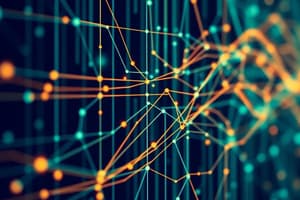Podcast
Questions and Answers
A particular neural network is showing low accuracy on new, unseen data, despite performing well on the training data. What is the most likely cause of this issue?
A particular neural network is showing low accuracy on new, unseen data, despite performing well on the training data. What is the most likely cause of this issue?
- Underfitting due to insufficient training data.
- The learning rate is set too low, preventing convergence.
- Overfitting due to excessive complexity of the network. (correct)
- The activation functions used are not suitable for the problem.
In a neural network designed for image classification, which layer is primarily responsible for identifying edges and basic shapes?
In a neural network designed for image classification, which layer is primarily responsible for identifying edges and basic shapes?
- The final hidden layers.
- The initial hidden layers. (correct)
- The output layer.
- The input layer.
Which of the following scenarios would benefit most from using a neural network with multiple hidden layers (a deep neural network) rather than a shallow network?
Which of the following scenarios would benefit most from using a neural network with multiple hidden layers (a deep neural network) rather than a shallow network?
- Filtering spam emails based on keyword analysis.
- Calculating the average of a set of numbers.
- Predicting stock prices based on historical data.
- Identifying handwritten digits. (correct)
When training a neural network, you notice that the validation loss starts increasing while the training loss is still decreasing. What does this indicate?
When training a neural network, you notice that the validation loss starts increasing while the training loss is still decreasing. What does this indicate?
What is the primary reason for using activation functions in the neurons of a neural network?
What is the primary reason for using activation functions in the neurons of a neural network?
If a neural network's weights are not properly initialized, what potential problem might arise during training?
If a neural network's weights are not properly initialized, what potential problem might arise during training?
When applying backpropagation, which of the following steps is crucial for ensuring effective weight updates?
When applying backpropagation, which of the following steps is crucial for ensuring effective weight updates?
What role does the bias term play in a neuron within a neural network?
What role does the bias term play in a neuron within a neural network?
A medical diagnosis system uses a neural network. What consequence could arise from using a biased training dataset that predominantly features data from one demographic group?
A medical diagnosis system uses a neural network. What consequence could arise from using a biased training dataset that predominantly features data from one demographic group?
A self-driving car uses a neural network to identify traffic signs, but is misclassifying stop signs in a particular neighborhood due to unusual lighting conditions and sign obstructions. What approach would best address this problem?
A self-driving car uses a neural network to identify traffic signs, but is misclassifying stop signs in a particular neighborhood due to unusual lighting conditions and sign obstructions. What approach would best address this problem?
Considering the role of weights in a neural network, how does increasing the magnitude of a weight affect a neuron's output, assuming all other factors remain constant?
Considering the role of weights in a neural network, how does increasing the magnitude of a weight affect a neuron's output, assuming all other factors remain constant?
When using a ReLU (Rectified Linear Unit) activation function, what potential issue can arise, and how is it characterized?
When using a ReLU (Rectified Linear Unit) activation function, what potential issue can arise, and how is it characterized?
In backpropagation, what information does the chain rule allow us to compute?
In backpropagation, what information does the chain rule allow us to compute?
Why might a neural network designed for natural language processing (NLP) require a large amount of training data?
Why might a neural network designed for natural language processing (NLP) require a large amount of training data?
What is a key difference between a feedforward neural network and a recurrent neural network (RNN)?
What is a key difference between a feedforward neural network and a recurrent neural network (RNN)?
Flashcards
Neural Network Inspiration
Neural Network Inspiration
Inspired by the structure and function of the human brain.
Neural Network Purpose
Neural Network Purpose
To identify patterns in data and make informed predictions based on those patterns.
Neural Network Layers
Neural Network Layers
Input Layer, Hidden Layer(s), Output Layer
Input Layer Data
Input Layer Data
Signup and view all the flashcards
Neuron Processing
Neuron Processing
Signup and view all the flashcards
Role of Weights
Role of Weights
Signup and view all the flashcards
Activation Function Use
Activation Function Use
Signup and view all the flashcards
Common Activation Function
Common Activation Function
Signup and view all the flashcards
Neural Network Training Method
Neural Network Training Method
Signup and view all the flashcards
Backpropagation Purpose
Backpropagation Purpose
Signup and view all the flashcards
Weight Update Algorithm
Weight Update Algorithm
Signup and view all the flashcards
How Gradient Descent Works
How Gradient Descent Works
Signup and view all the flashcards
Hidden Layers
Hidden Layers
Signup and view all the flashcards
Neuron Connections
Neuron Connections
Signup and view all the flashcards
No Hidden Layers
No Hidden Layers
Signup and view all the flashcards
Study Notes
Basic Understanding
- Neural networks are inspired by the human brain.
- Neural networks recognize patterns and make predictions.
- The three main types of layers in a neural network include the input layer, hidden layer(s), and output layer.
- The input layer receives raw data such as pixels from an image.
Working Mechanism
- Neurons in a neural network process inputs through activation functions.
- Weights in a neural network determine how important an input is.
- Activation functions introduce non-linearity in the model.
- A commonly used activation function is ReLU (Rectified Linear Unit).
Training Process
- Backpropagation trains a neural network.
- The purpose of backpropagation is to adjust weights and minimize error.
- Gradient descent is the algorithm used to update the weights in backpropagation.
- Gradient descent calculates the direction to reduce error.
Neural Network Structure
- In the hidden layers, data is transformed through weighted connections.
- Weights connect the neurons in a neural network.
- Without hidden layers, a neural network may not learn complex patterns.
Applications and Use Cases
- A major application of neural networks include is image recognition.
- Medicine and healthcare heavily rely on neural networks for predictions.
- AI-based chatbots are built on neural networks.
Advanced Concepts
- Neural networks require vast amounts of data to improve accuracy and generalization.
- A neural network that is too complex with too many layers may overfit the data.
Studying That Suits You
Use AI to generate personalized quizzes and flashcards to suit your learning preferences.




